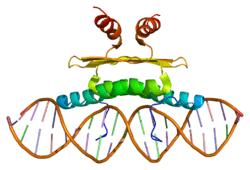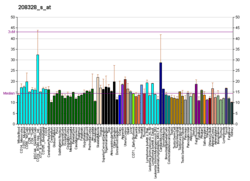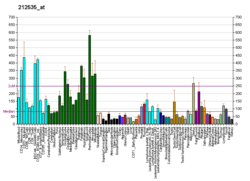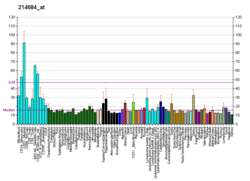Myocyte-specific enhancer factor 2A
Myocyte-specific enhancer factor 2A is a protein that in humans is encoded by the MEF2A gene.[5][6] MEF2A is a transcription factor in the Mef2 family. In humans it is located on chromosome 15q26. Certain mutations in MEF2A cause an autosomal dominant form of coronary artery disease and myocardial infarction.
Function
The process of differentiation from mesodermal precursor cells to myoblasts has led to the discovery of a variety of tissue-specific factors that regulate muscle gene expression. The myogenic basic helix-loop-helix proteins, including myoD (MIM 159970), myogenin (MIM 159980), MYF5 (MIM 159990), and MRF4 (MIM 159991) are 1 class of identified factors. A second family of DNA binding regulatory proteins is the myocyte-specific enhancer factor-2 (MEF2) family. Each of these proteins binds to the MEF2 target DNA sequence present in the regulatory regions of many, if not all, muscle-specific genes. The MEF2 genes are members of the MADS gene family (named for the yeast mating type-specific transcription factor MCM1, the plant homeotic genes 'agamous' and 'deficiens' and the human serum response factor SRF (MIM 600589)), a family that also includes several homeotic genes and other transcription factors, all of which share a conserved DNA-binding domain.[supplied by OMIM][6]
Interactions
Myocyte-specific enhancer factor 2A has been shown to interact with:
References
- 1 2 3 GRCh38: Ensembl release 89: ENSG00000068305 - Ensembl, May 2017
- 1 2 3 GRCm38: Ensembl release 89: ENSMUSG00000030557 - Ensembl, May 2017
- ↑ "Human PubMed Reference:".
- ↑ "Mouse PubMed Reference:".
- ↑ Yu YT, Breitbart RE, Smoot LB, Lee Y, Mahdavi V, Nadal-Ginard B (October 1992). "Human myocyte-specific enhancer factor 2 comprises a group of tissue-restricted MADS box transcription factors". Genes Dev. 6 (9): 1783–98. doi:10.1101/gad.6.9.1783. PMID 1516833.
- 1 2 "Entrez Gene: MEF2A MADS box transcription enhancer factor 2, polypeptide A (myocyte enhancer factor 2A)".
- ↑ Mao Z, Nadal-Ginard B (June 1996). "Functional and physical interactions between mammalian achaete-scute homolog 1 and myocyte enhancer factor 2A". J. Biol. Chem. 271 (24): 14371–5. doi:10.1074/jbc.271.24.14371. PMID 8662987.
- 1 2 De Luca A, Severino A, De Paolis P, Cottone G, De Luca L, De Falco M, Porcellini A, Volpe M, Condorelli G (February 2003). "p300/cAMP-response-element-binding-protein ('CREB')-binding protein (CBP) modulates co-operation between myocyte enhancer factor 2A (MEF2A) and thyroid hormone receptor-retinoid X receptor". Biochem. J. 369 (Pt 3): 477–84. doi:10.1042/BJ20020057. PMC 1223100. PMID 12371907.
- 1 2 Miska EA, Karlsson C, Langley E, Nielsen SJ, Pines J, Kouzarides T (September 1999). "HDAC4 deacetylase associates with and represses the MEF2 transcription factor". EMBO J. 18 (18): 5099–107. doi:10.1093/emboj/18.18.5099. PMC 1171580. PMID 10487761.
- 1 2 3 Lemercier C, Verdel A, Galloo B, Curtet S, Brocard MP, Khochbin S (May 2000). "mHDA1/HDAC5 histone deacetylase interacts with and represses MEF2A transcriptional activity". J. Biol. Chem. 275 (20): 15594–9. doi:10.1074/jbc.M908437199. PMID 10748098.
- ↑ Zhao M, New L, Kravchenko VV, Kato Y, Gram H, di Padova F, Olson EN, Ulevitch RJ, Han J (January 1999). "Regulation of the MEF2 family of transcription factors by p38". Mol. Cell. Biol. 19 (1): 21–30. doi:10.1128/mcb.19.1.21. PMC 83862. PMID 9858528.
- ↑ Yang SH, Galanis A, Sharrocks AD (June 1999). "Targeting of p38 mitogen-activated protein kinases to MEF2 transcription factors". Mol. Cell. Biol. 19 (6): 4028–38. doi:10.1128/mcb.19.6.4028. PMC 104362. PMID 10330143.
- ↑ Ornatsky OI, McDermott JC (October 1996). "MEF2 protein expression, DNA binding specificity and complex composition, and transcriptional activity in muscle and non-muscle cells". J. Biol. Chem. 271 (40): 24927–33. doi:10.1074/jbc.271.40.24927. PMID 8798771.
- ↑ Quinn ZA, Yang CC, Wrana JL, McDermott JC (February 2001). "Smad proteins function as co-modulators for MEF2 transcriptional regulatory proteins". Nucleic Acids Res. 29 (3): 732–42. doi:10.1093/nar/29.3.732. PMC 30396. PMID 11160896.
Further reading
- Wang Q (2005). "Advances in the Genetic Basis of Coronary Artery Disease". Current atherosclerosis reports. 7 (3): 235–41. doi:10.1007/s11883-005-0012-6. PMC 1783687. PMID 15811259.
- Wang Q (2005). "Molecular genetics of coronary artery disease". Curr. Opin. Cardiol. 20 (3): 182–8. doi:10.1097/01.hco.0000160373.77190.f1. PMC 1579824. PMID 15861005.
- Funk WD, Wright WE (1992). "Cyclic amplification and selection of targets for multicomponent complexes: myogenin interacts with factors recognizing binding sites for basic helix-loop-helix, nuclear factor 1, myocyte-specific enhancer-binding factor 2, and COMP1 factor". Proc. Natl. Acad. Sci. U.S.A. 89 (20): 9484–8. doi:10.1073/pnas.89.20.9484. PMC 50156. PMID 1329097.
- Pollock R, Treisman R (1992). "Human SRF-related proteins: DNA-binding properties and potential regulatory targets". Genes Dev. 5 (12A): 2327–41. doi:10.1101/gad.5.12a.2327. PMID 1748287.
- Molkentin JD, Black BL, Martin JF, Olson EN (1996). "Cooperative activation of muscle gene expression by MEF2 and myogenic bHLH proteins". Cell. 83 (7): 1125–36. doi:10.1016/0092-8674(95)90139-6. PMID 8548800.
- Hobson GM, Krahe R, Garcia E, Siciliano MJ, Funanage VL (1996). "Regional chromosomal assignments for four members of the MADS domain transcription enhancer factor 2 (MEF2) gene family to human chromosomes 15q26, 19p12, 5q14, and 1q12-q23". Genomics. 29 (3): 704–11. doi:10.1006/geno.1995.9007. PMID 8575763.
- Mao Z, Nadal-Ginard B (1996). "Functional and physical interactions between mammalian achaete-scute homolog 1 and myocyte enhancer factor 2A". J. Biol. Chem. 271 (24): 14371–5. doi:10.1074/jbc.271.24.14371. PMID 8662987.
- Suzuki E, Lowry J, Sonoda G, Testa JR, Walsh K (1996). "Structures and chromosome locations of the human MEF2A gene and a pseudogene MEF2AP". Cytogenet. Cell Genet. 73 (3): 244–9. doi:10.1159/000134348. PMID 8697817.
- Ornatsky OI, McDermott JC (1996). "MEF2 protein expression, DNA binding specificity and complex composition, and transcriptional activity in muscle and non-muscle cells". J. Biol. Chem. 271 (40): 24927–33. doi:10.1074/jbc.271.40.24927. PMID 8798771.
- Black BL, Molkentin JD, Olson EN (1998). "Multiple Roles for the MyoD Basic Region in Transmission of Transcriptional Activation Signals and Interaction with MEF2". Mol. Cell. Biol. 18 (1): 69–77. doi:10.1128/mcb.18.1.69. PMC 121453. PMID 9418854.
- Yang CC, Ornatsky OI, McDermott JC, Cruz TF, Prody CA (1998). "Interaction of myocyte enhancer factor 2 (MEF2) with a mitogen-activated protein kinase, ERK5/BMK1". Nucleic Acids Res. 26 (20): 4771–7. doi:10.1093/nar/26.20.4771. PMC 147902. PMID 9753748.
- Zhao M, New L, Kravchenko VV, Kato Y, Gram H, di Padova F, Olson EN, Ulevitch RJ, Han J (1999). "Regulation of the MEF2 Family of Transcription Factors by p38". Mol. Cell. Biol. 19 (1): 21–30. doi:10.1128/mcb.19.1.21. PMC 83862. PMID 9858528.
- Yang SH, Galanis A, Sharrocks AD (1999). "Targeting of p38 Mitogen-Activated Protein Kinases to MEF2 Transcription Factors". Mol. Cell. Biol. 19 (6): 4028–38. doi:10.1128/mcb.19.6.4028. PMC 104362. PMID 10330143.
- Iida K, Hidaka K, Takeuchi M, Nakayama M, Yutani C, Mukai T, Morisaki T (1999). "Expression of MEF2 genes during human cardiac development". Tohoku J. Exp. Med. 187 (1): 15–23. doi:10.1620/tjem.187.15. PMID 10458488.
- Miska EA, Karlsson C, Langley E, Nielsen SJ, Pines J, Kouzarides T (1999). "HDAC4 deacetylase associates with and represses the MEF2 transcription factor". EMBO J. 18 (18): 5099–107. doi:10.1093/emboj/18.18.5099. PMC 1171580. PMID 10487761.
- Mao Z, Bonni A, Xia F, Nadal-Vicens M, Greenberg ME (1999). "Neuronal activity-dependent cell survival mediated by transcription factor MEF2". Science. 286 (5440): 785–90. doi:10.1126/science.286.5440.785. PMID 10531066.
- Lu J, McKinsey TA, Nicol RL, Olson EN (2000). "Signal-dependent activation of the MEF2 transcription factor by dissociation from histone deacetylases". Proc. Natl. Acad. Sci. U.S.A. 97 (8): 4070–5. doi:10.1073/pnas.080064097. PMC 18151. PMID 10737771.
- Lemercier C, Verdel A, Galloo B, Curtet S, Brocard MP, Khochbin S (2000). "mHDA1/HDAC5 histone deacetylase interacts with and represses MEF2A transcriptional activity". J. Biol. Chem. 275 (20): 15594–9. doi:10.1074/jbc.M908437199. PMID 10748098.
- Youn HD, Grozinger CM, Liu JO (2000). "Calcium regulates transcriptional repression of myocyte enhancer factor 2 by histone deacetylase 4". J. Biol. Chem. 275 (29): 22563–7. doi:10.1074/jbc.C000304200. PMID 10825153.









